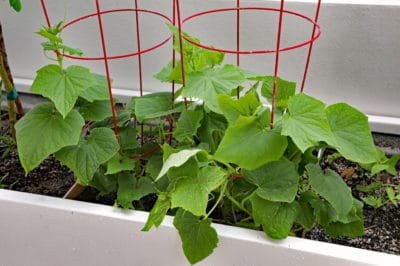Choosing the Right Cukes
For the best chance of succeeding with indoor cukes, purchase already-started plants from your local nursery or a reputable online vendor. Readily available bush varieties include:
- ‘Bush Champion,’ producing 8- to 12-inch slicing cukes on an 8-inch in height, two-foot wide plant.
- ‘Picklebush,’ the same size as ‘Bush Champion’ but with white-spined, 4.5-inch pickling cukes.
- ‘Salad Bush Hybrid,’ 26-inches wide and 6- to 8-inches high with sweet, crisp 8-inch slicing fruit.
The Container
A container measuring 12 inches deep and 8 inches across has plenty of room to accommodate a bush cucumber’s expanding root system. Choose one with a drainage hole on the bottom.
Adding the Growing Medium
For a growing medium, you’ll need:
- Potting soil with vermiculite
- Organic compost
- Sphagnum peat moss
Put equal parts of each ingredient to a large container and gradually add water, mixing until it’s evenly moist.
Set your planting pot in the sink or a plastic drainage tray, then fill it two-thirds full with the growing medium.
Expert gardener’s tip: Including good organic compost in your potting mix eliminates the need for additional fertilizer.
How to Transplant the Cuke
Invert your starter cuke’s pot, tap lightly on its bottom and gently slide the plant free. Cucumbers are susceptible to transplant shock, so disturb the roots as little as possible. Center the plant in the new container, fill around it with growing medium, gently tamp down and water thoroughly.
Where to Position the Container
Move the container and drainage tray to a location with at least 6 hours of direct daily sun. During summer, a large south-facing window is ideal; southeastern or southwestern exposures are second-best. If necessary, supplement your natural light with full-spectrum LED grow lights hung 6 to 8 inches above the plant.
Expert gardener’s tip: A new cat litter box makes a great drainage tray for an indoor cuke.
Watering
Check your cucumber daily and water when the surface of the growing medium feels dry to the touch. Once the flowers and fruit appear it may need as much as 1 gallon (3.78 liters) of water a day, delivered in two or three portions.
Expert gardener’s tip: To conserve water, keep your cucumber no warmer than 78°F (26°C).
How to Hand Pollinate
Indoor-grown cucumbers don’t benefit from pollinating insects, so you’ll have to fill in. Swirl a soft-bristle artist’s brush over a male flower’s central stamen to collect pollen. Then transfer the pollen to the center of a female flower – one with a swollen stem that’s actually an ovary. After that, let Nature take its course!
